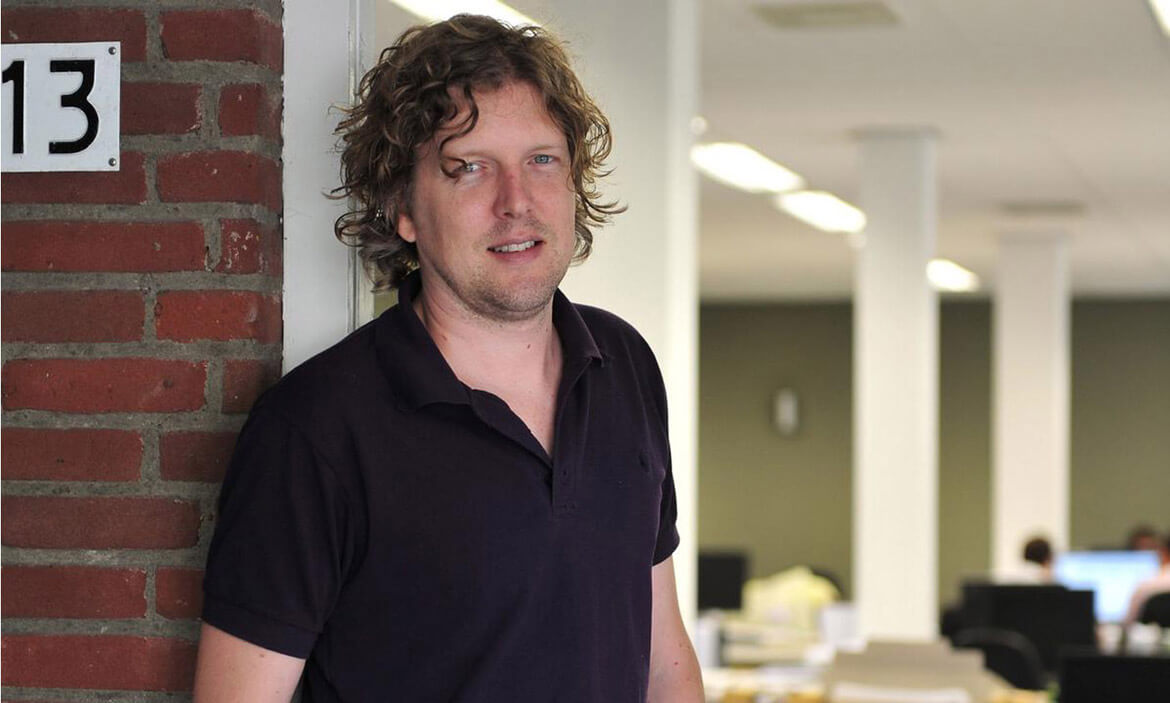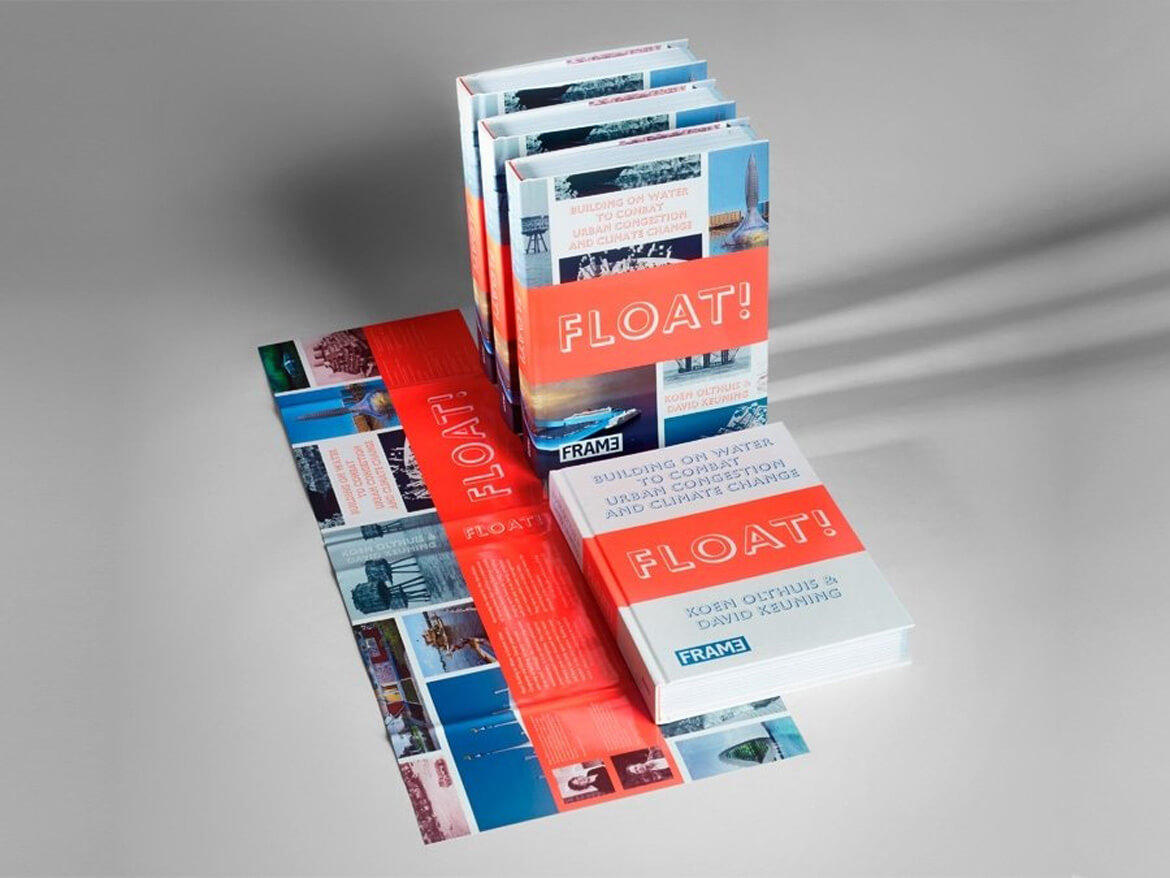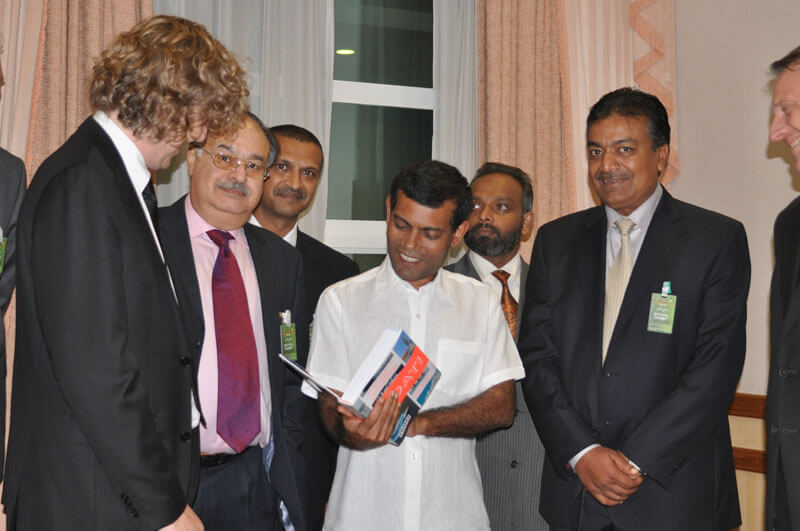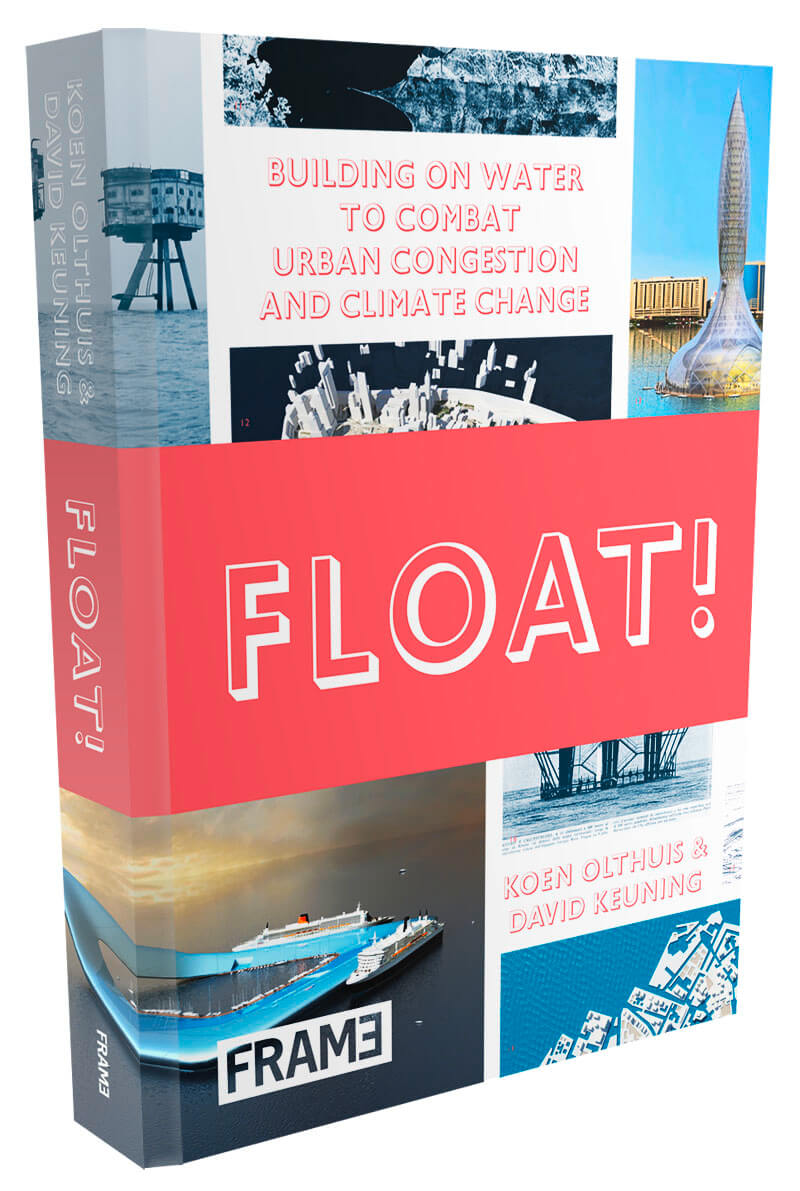The 100 that will change the world in 2011

Future Fashion, Tanya Palta
Koen Olthuis one of the 18 green guardian angels who protect our environment

Future Fashion, Tanya Palta
Koen Olthuis one of the 18 green guardian angels who protect our environment

Inhabitat: “World-renowned architect Koen Olthuis is the leading designer of floating structures. Recently, he finished a new book, called FLOAT! read on for our exclusive interview!”
Inhabitat interview: Waterstudio’s Koen Olthuis on FLOAT!
Written by Inhabitat, Bridgette Meinhold
World-renowned architect Koen Olthuis is the leading designer of floating structures — he has built a number of floating houses all over the world and has designed for the likes of Dubai and other metropolises. Koen Olthuis of Waterstudio and David Keuning of Mark Magazine have also authored a book, called FLOAT!, which is a compendium of his knowledge on floating architecture. He details historical projects, discusses the practical uses for floating architecture, explores scenarios for a future world with higher sea levels, and rallies behind sustainability as a necessity for future development on the water. In between his busy travel schedule, Koen was able to take some time to answer a few questions about the future of hydrocities and building on the water – read on for our exclusive interview!

SFGate and San Francisco Chronicle has listed FLOAT! in the top 10 of Best Science Books 2010.
Top 10 Best Science Books 2010
Written by SFGate, John King
Koen Olthuis had the honour to present the first copy of the book FLOAT! to President Nasheed who has been chosen by Newsweek magazine as one of the “world’s ten best leaders”.
President Maldives
Koen Olthuis presented the first copy of the book “FLOAT!” to President Nasheed of the Republic of Maldives
Male, Maldives, 16 September 2010.
Koen Olthuis had the honour to present the first copy of the book “FLOAT!, to combat urban congestion and climate change” to President Nasheed of the Republic of Maldives, who has been chosen by Newsweek magazine as one of the “world’s ten best leaders.”
Newsweek lauds the President as a “green guru” and a “hero among environmentalists” for his efforts to prod the world into action against climate change, which threatens the Maldives and other vulnerable nations.
“In the run-up to last year’s United Nations climate-change meeting, Nasheed attracted global attention by hosting a cabinet meeting underwater. In Copenhagen, he shamed rich governments by pledging to make the Maldives the world’s first carbon-neutral nation,” reads the Newsweek article.
Al Gore likes to quote him on the human cost of climate change. And in April, the U.N. elected him one of six ‘2010 Champions of the Earth,’.


Title: FLOAT! building on water to combat urban congestion and climate change. The book officially launches October 2010.
FLOAT!
Written by Waterstudio

The New York Times, Peter Edinin
ROM Jakarta to the coast of Louisiana, floodwaters are a growing concern. This is especially true in delta regions, where river and sea combine, as they do in many of the world’s great cities, to create a double hazard.
No place is more concerned with this problem than the Netherlands, literally “the lowlands,” where for centuries people have lived on the edge of water-borne disaster. About a quarter of the country is land reclaimed from the sea, while half of it lies at or below sea level. The country’s vulnerability to rising water levels, commonly ascribed to climate change, was on full display last summer at the Rotterdam Architecture Biennale, titled “The Flood,” which contained proposals for a floating soccer stadium and housing built on spongelike synthetic riverbanks capable of absorbing flood waters.
“Since World War II, the Dutch have relied on technology for protection from the rivers and the sea,” said Adriaan Geuze, a landscape architect and the chief curator of the biennale. “We are convinced that this is not a clever way to deal with reality, and three months after the exhibition closed, Katrina showed us the truth of that.”
For the Dutch, as for everyone else, there appear to be no simple solutions, only costly ones, like abandoning vulnerable terrain. For the first time in its long history, the Netherlands has begun to strategically uncreate itself; last year the government, at the start of a 15-year program, began buying up land and reserving it as flood plain, mostly along river banks. The Dutch are also exploring a solution as old as the first flood: floating architecture. The notion is still in its early stages, with only a handful of houses built and a few developments under way, but it has already attracted the attention of leading Dutch designers and some developers.
If it proves sufficiently functional, affordable and attractive, floating architecture could find its way to many of the world’s flood zones.
In the town of Aalsmeer, in the southwest, an area badly damaged by floods in 1953, Sjef Snel and his wife, Agnes, moved into their floating house a little more than a year ago. “It took me over six months to settle down,” Mr. Snel said, “and then I knew I was at the right place.”
Even better, Mr. Snel, 45, says he has no more concerns about flooding. “I feel totally safe,” he said. “Our living room is eight inches above water and the house is mobile. There is certainly no reason to be fearful.”
The house was designed by Agnes Snel in collaboration with Koen Olthuis, a 34-year-old Dutch architect who has emerged as a leading advocate for floating buildings. His small practice, called Waterstudio, is devoted exclusively to such projects. “Most of these projects are in the first phase,” Mr. Olthuis said from his offices in Rijswijk, “since using water, not just defending against it, is a new idea.”
Dura Vermeer, one of the country’s largest builders, is also experimenting with floating structures. It has created a community of 48 amphibious homes in Maasbommel, on the banks of the Maas river. The brightly colored 700-square-foot homes, designed by Factor Architecten, a large design firm based in Amsterdam, are set in what was once a parking area for recreational vehicles. “These are not houseboats,” said Ger Kengen of Factor. “You have to design everything as if it were on the ground, only 10 feet up in the air.”
Anna van der Molen, 45, who lives with her husband and child in one of the houses, said “not only do we live on water, but we also live with water.” The houses sit on concrete pontoons that rest on footings projected slightly above the river bottom at low water periods, but ride up during floods along a pair of 15-foot poles. Their low center of gravity, created by the weight of the pontoons, makes them very stable. Still, Ms. van der Molen said, “Sometimes it is scary, very scary, when the water is coming up.”
Chris Zevenbergen, the director for business development of Dura Vermeer, said, “We decided five years ago to take water as one of our strategic objectives. The company is also designing a “floating city,” for 12,000 people near Schiphol Airport, not far from Amsterdam, in the fastest growing area of the country. The design will cost more than $1.2 million, 45 percent of which will be paid for by the government. The goal is a town that can live with flooding, not just wall it off, using a variety of floating structures and an extensive system for rainwater storage, among other means. The challenge is aesthetic as well as commercial, notes Herman Hertzberger, who at 73 is regarded by many as the grand old man of Dutch architecture. No one yet knows what waterborne housing should look like, he said, or how it should function. Mr. Hertzberger offered some possibilities several years ago in the design of an amphibious house that revolves on a base of massive steel pontoons, turning the house, “toward the sun or away from a neighbor,” he said. The house is in Middelburg, the capital of Zeeland, the area hardest hit by the 1953 flood, which killed more than 1,800 people.
The prototype, now owned by Don Monfils, an architect, and his wife, Lidia Filius, brought a commission from a Dutch builder to create two clusters of floating houses, each set on long concrete foundations, in the same area. There will be about 20 houses in all, Mr. Hertzberger said.
But it remains to be seen how waterborne homes, as a form, will evolve.
“The problem I have is that I have not seen any great examples of contemporary floating architecture,” said Aaron Betsky, director of the Netherlands Architecture Institute in Rotterdam. “What makes a floating house different than a houseboat?”
Giving land back to the river and the sea is a solution that will create its own problems. The Netherlands is small and among the world’s most densely populated countries, so the lands set aside for water must be put to productive use.
Bart Mispelblom Beyer, a principal with Tangram, a well-known Dutch architectural office, said his firm has designed 85 houses for a tidal zone near the southern city of Dordrecht. The buildings, which will rise and fall with the tide, are being built on tidal lands because that was the only site for new homes the developer could find.
A few months ago, the Ministry of Housing, Spatial Planning and the Environment announced that it was accepting proposals to develop amphibious and other types of flood-resilient structures in 15 flood-prone areas. These are places, like the plains between rivers and the dikes that hold back their waters, in which the Dutch have never permitted construction.
Some architects remain skeptical about the large-scale feasibility of floating homes. Art Zaaijer designed six houses for a lakeside development at IJburg, outside Amsterdam. They are amphibious, and since they sit in a nature preserve, are designed to be nonpolluting.
Unfortunately, Mr. Zaaijer said, development has been stalled by an economic slowdown, and his houses, he said with a mixture of amusement and chagrin, have been occupied by squatters. “There are squatters from all over the world there,” he said, “totally happy, living in exceptional houses with wonderful views. Last time I went by I met a group of Brazilian painters.”
Mr. Zaaijer clearly loves these homes, but he is skeptical about the contribution such structures will make. “We have six or seven million houses in Holland,” he said, “and this will always be a marginal addition to them.”
Mr. Betsky is not quite so pessimistic, but he acknowledges significant obstacles. “In most of the designs I’ve seen,” he said, “the houses are isolated objects connected to the shore by a thin umbilical cord.”
“A luxurious isolation tank seems to be the destiny of many Dutch lakes and rivers,” he added. “Might there be a community like what one finds in Southeast Asia, where the houses connect to each other as well? I am still looking for good examples.”
Der Spiegel
Looking out from the terrace, heaven and earth merge into a grey blur. Heavy rain pours so incessantly that one would expect Anne van der Molen to be getting just a little nervous.
“Tomorrow does not look any better, according to the weather forecast,” she says, calmly sipping her coffee. She does so in spite of the fact that her house stands directly on the Maas dyke – on the side facing the river, to be exact. Yet the nurse, sitting on her garden chair under the awning, feels as cozy and safe as if she were “snowed in up in a mountain hut, with a log fire glowing and the pantry full.” The Maas can go on rising as much as it likes, for all she cares. Her house can swim. As the water level climbs, the house itself can move up five meters, if necessary. “The elements don’t bother me,” she says.
There are 37 houses strung along this branch of the Maas like a row of beads. At first glance, they seem quite unremarkable. Two storeys high, semicircular metal roofs and yellow, green or blue facades – hardly any clues let on that these are The Netherlands’ first amphibious houses. The cellar, in this case, is not built into the earth. Instead, it is on a platform – and is much more than a mere storage room. The hollow foundation of each house works in the same way as the hull of a ship, buoying the structure up above water. To prevent the swimming houses from floating away, they slide up two broad steel posts – and as the water level sinks, so they sink back down again.
“The columns have been driven deep into solid ground,” explains Dick van Gooswilligen from the Dura Vermeer construction company. “They are even strong enough to withstand currents you would find on the open seas.” Gooswilligen is currently busy guiding dozens of journalists from the United States through the watertight settlement in the Maasbommel district, close to Nijmegen. “As global warming causes the sea level to rise, this is the solution,” he explains into a microphone. “Housing of this type is the future for the delta regions of the world, the ones which face the greatest danger.”
Soundbites like these are just what Americans want to hear these days. Hurricane Katrina and her lesser cousin Hurricane Rita have sparked interest in the low lying Netherlands. Hordes of hydraulic engineers from Louisiana or Texas are making the pilgrimage to the North Sea coastline to look at the fortifications. The inland river dykes are also considered exemplary models.
The Netherlands Sinks a little Lower Every Year
German catastrophe management teams are just as curious. Climate patterns today suggest that torrential rainfall is something we can expect plenty more of in the future. This year’s floods in the Alps or those along the River Elbe three years ago could well be warning signs of what awaits us. Climatologists predict that precipitation in The Netherlands could increase as much as 25 percent. At the same time, because of the small kingdom’s dense population, there is increasing pressure to build in areas prone to flooding. Already, though, the country defies the laws of physics simply by existing: More than a quarter of its land lies below sea level. And, year by year, the land is sinking a little bit lower. The Dutch protect themselves from going under through a network of canals and pumps. It is not only the sea which threatens the mighty barrage on the coast. On the other side lies the Rhine River, which branches out and forms a wide-reaching delta with the Maas. To prevent such huge swaths of land from flooding in summer and winter storms, the Dutch are designating more and more land along their rivers as flood zones. Within the next few decades, the area will compose close to 500,000 hectares — or about twice the size of the German state of Saarland.
This will only be possible if people, industry and agriculture can be successfully relocated to safe territory – which is hard to imagine, given the resistance mounted by some of those affected. Officials have, therefore, decided to demonstrate first of all that it is possible to live in the so-called flood zones. In early October, 15 test areas were announced. A stringent ban on construction in these areas has now been lifted – provided buildings constructed are amphibious houses and nothing else. This means that, in a worst case scenario, excess water from flooded rivers can still be diverted this way.
“You cannot fight water, you have to learn how to live with it”, states Sybilla Dekker, the minister in charge. Her department has arranged a competition for engineers, urban planners and architects to design living accommodation, greenhouses, parking lots and factories which would float and could grow into “waterproof” towns.
One of the leading architects in this relatively new discipline of maritime architecture is Koen Olthuis. His aptly named Waterstudio.nl office has already designed a number of contemporary houseboats with a parking deck for the car and lower deck storage for a motorboat. Now, his team is even coming up with plans for office buildings a hundred meters in height that “swim.” The key to making this idea a reality is a patented technique whereby the foundation of the construction can be transformed into a float. A foam core is encased in concrete, with steel cables securing it against the pull of potential currents. Individual pontoons, whether for residential blocks or chicken coops, can be joined to one another like Lego blocks. As a result, a maritime settlement is born.
“This construction model is built to last at least one hundred years,” Olthuis says. If anything should happen to the foundation, there is no need to call in the construction company. Instead, the whole thing can be taken to the dockyard.
Family “arks” of the future
The architect from Rijswijk hopes to tap into a worldwide trend. Increasing numbers of people are gravitating towards the water, out of necessity, for financial gain or, in some cases, quite simply for the wonderful view. “Thanks to watertight buildings, this impulse need not be fateful,” he says. His bobbing buildings have not only found favor in the Polder lands, he has also prepared concepts for Dubai.
The first town based on this model, numbering 12,000 houses, might conceivably be built close to Amsterdam’s Schiphol airport. The Netherlands are particularly low in this area. When planes come in for a landing here, one can see countless rectangular islets amid a picturesque, watery landscape. Canals weave their way like veins through the swaying reeds of green land which invariably opens out into ponds or lakes. By the year 2010, amphibious houses like those in Maasbommel may well form the first residential area here – or perhaps greenhouses will dominate the landscape, like the one opened earlier this month by the minister of agriculture in The Hague.
At this stage, such model houses cost more than conventional housing. The amphibious buildings in Maasbommel cost approximately 250,000 to 300,000 for a 120 square meter home. This is due in part to the flexible nature of the construction which also plays a role in creating feed lines for gas, electricity, drinking water and drainage. Like the foundation, they, too, have to be able to adapt to the changes in height of the premises.
But, when the floating construction model goes more mainstream, the price of a one family “ark” should drop dramatically. “At the end of the day, we will save on a lot of the costs conventional building methods incur doing things like securing foundations in soft ground. We won’t have to contend with that,” Olthuis points out. It remains an utter mystery to him why water-proofed construction is not yet common practice.
He can only watch and shake his head as his television broadcasts fresh pictures of floods in one part of the world or another. “Those people, breaking their backs piling sandbags on their doorsteps, I feel really sorry for them.”